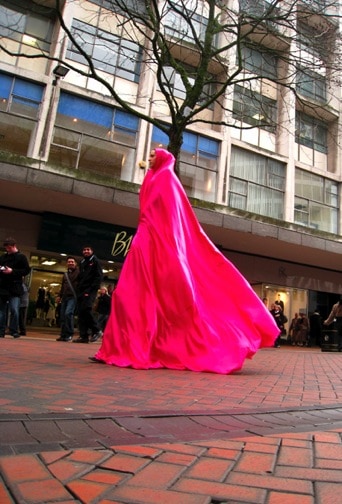These fieldnotes are part of an on-going research on the Islamic legal culture of England. This research, which I started in 2009, aims to capture the new cultural assemblages that have emerged in the European public sphere as a result of the increased visibility of Islam. While underlying the unintended and paradoxical effects of State interventions in the domain of ‘race-relations’, it displaces current debates on ‘Islamism’ from a focus on organised religious movements to one that is sensitive to everyday social practices. I argue that Islam in England can be read as a ‘framework’, in the sense of Charles Taylor, for exploring the Self, identity and the ‘good ethical life’.

In Birmingham inner city, women’s absent presence asserts itself through the increased popularity of niqabs. I recall now this fully covered woman called Aisha whom I met at the Brigthon mosque. She wanted to teach me how to pray and guided me to the women’s section, where she could privately show me the moves of ‘salat’. From behind her facial veil, I had noticed her distinctive working class accent but I could barely hide my astonishment when she eventually uncovered her face to reveal piercings of various shapes and colors. ‘I have done many bad things in my life…you know…very bad things… but now I pray Allah and seek his forgiveness. He is the most merciful, the most compassionate!’, she had told me as if wanting to excuse herself for my puzzlement at this unexpected vision of Taqwacore (Knight 2004). She had married a Moroccan man some years ago and had come to Islam through him. As we went to collect our shoes prior to leaving the mosque, I saw her pick up a pair of heavy boots with metal lining, the typical attire of British punks. My disorientation was now total.
Sonia, another young woman in her twenties I met at a course on shari’ah law at the Muslim College in West London, was on her way to adopt that dress too. Arrived from Pakistan with her family at the age of 10, she obtained an A-level in History and Philosophy from a London University. Her parents were divorced and she now lived in a small house in Barnet with her mother who struggled to make ends meet and her six siblings. She admitted that her family was not very religious and watched episodes of Eastenders at weekends, ‘like most Brits do’. It was her dissatisfaction with the type of knowledge she had received at University, in particular philosophical discussions around the ‘death of God’, that made her feel like knowing more about Islam. She was enrolled in various courses, at her local mosque, at the Muslim College and in private women’s circles and worked part-time in a retail fashion store. As much as she was aware that wearing the niqab would make her life more complicated, she had gained enough self-confidence in the process of rediscovering her faith to make this ultimate step. And as she tried to explain her choice to me, I found myself amazed by her determination:
I don’t need permission from anyone to know what I need to do, what I can do and what I can’t do because if I’m doing something within the boundaries of the Sharia, and I’m not harming other people then that should be fine. I’m doing it for the sake of God and why would that be a problem? Why would I need the whole ijma from everyone? Because not everyone will agree on this topic anyway. Everyone is bound to have his or her own opinion.
In contrast with the black color of inner city niqabs, Birmingham city centre exhibits a rainbow of hijabs and the latest trends of Islamic fashion. Even international brands of prêt-à-porter, like Zara and H&M, seem to have been influenced by the global Islamic revival. In the shop windows, an extravaganza of colourful headgears, cagoules and hoods of various designs are displayed.
Mitra Mermazia, a British Iranian artist, captures the transformations of public life in her city with humour and poetry. In one of her recent performances entitled ‘Who’s afraid?’ in reference to the popular 1930s song written by Frank Churchill ‘Who’s afraid of the big bad wolf’, she walked the streets of the Bullring, in Birmingham city centre, perched on stilts and dressed with an all covering pink chador. Her silent strolling amidst the crowd, towering over passers-by, looking at the distance or at the tops of buildings as if preparing to fly, was meant to convey surrealistic impressions. Her phantomatic appearance triggered mixed reactions: some took pictures, as if confronted by an entertaining clown, while others simply pretended that she did not exist. But altogether, this poetic apparition under the flashy fabric joyfully challenged mainstream perceptions of Islam as a threat to public order, interrogating with humour the machinery of truth that shapes public perceptions with clear-cut certainties.
This impromptus catwalk highlights the power of the public sphere to stage contrasted identitarian performances. Indeed, the public space is primarily a space in which social actors play social roles and present themselves to others (Goffman 1969). Because of the democratic lack that has marked British politics since the 1980s, the public has become an important site of popular expression. The vibrant avant-garde rock scene, the British taste for costume (as the urban tribes exhibiting their exuberant attires remind us), the giant demonstrations against the war in Iraq in 2003, all these manifestations testify of the vitality of the public for voicing popular contestation and expressing identities.
References:
Goffman, Erving. 1969. The Presentation of Self in Everyday Life. London: Allen Lane.
Göle, Nilüfer. 2000. “Snapshots of Islamic Modernities.” Daedalus 129 (1): 91–117.
Knight, Michael Muhammad. 2004. The Taqwacores. Soft Skull Press. Berkeley.
Taylor, Charles. 1989. Sources of the Self: The Making of the Modern Identity. Harvard University Press.
Featured image: Princess Hijab




